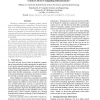Free Online Productivity Tools
i2Speak
i2Symbol
i2OCR
iTex2Img
iWeb2Print
iWeb2Shot
i2Type
iPdf2Split
iPdf2Merge
i2Bopomofo
i2Arabic
i2Style
i2Image
i2PDF
iLatex2Rtf
Sci2ools
ICSE
2003
IEEE-ACM
2003
IEEE-ACM
A Component Architecture for an Extensible, Highly Integrated Context-Aware Computing Infrastructure
Ubiquitous context-aware computing systems present several challenges in their construction. Principal among them is the tradeoff between easily providing new contextaware services to users and the tight integration of those services, as demanded by the small form factor of the devices typically found in ubiquitous computing environments. Performance issues further complicate the management of this tradeoff. Mechanisms have been proposed and toolkits developed for aiding the construction of context-aware systems, but there has been little consideration of how to specialize, organize, and compose these mechanisms to meet the above requirements. We motivate and describe a software architecture that provides the desired integration and extensibility of services in a context-aware application infrastructure. A key result is the fissioning of intuitive class organizations, both across layers and within layers, to achieve the required integration of services and separation of concerns.
| Added | 09 Dec 2009 |
| Updated | 09 Dec 2009 |
| Type | Conference |
| Year | 2003 |
| Where | ICSE |
| Authors | William G. Griswold, Robert T. Boyer, Steven W. Brown, Tan Minh Truong |
Comments (0)

